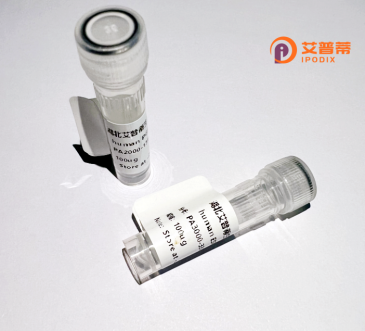
| 纯度 | >90%SDS-PAGE. |
| 种属 | Human |
| 靶点 | AOF2 |
| Uniprot No | O60341 |
| 内毒素 | < 0.01EU/μg |
| 表达宿主 | E.coli |
| 表达区间 | 1-876aa |
| 氨基酸序列 | MLSGKKAAAAAAAAAAAATGTEAGPGTAGGSENGSEVAAQPAGLSGPAEVGPGAVGERTPRKKEPPRASPPGGLAEPQGSAGPQAGPTVVPGSATPMETGIAETPEGRRTSRRKRAKVEYREMDESLANLSEDEYYSEEERNAKAEKEKKLPPPPPQAPPEEENESEPEEPSGQAGGLQDDSSGGYGDGQASGVEGAAFQSRLPHDRMTSQEAACFPDIISGPQQTQKVFLFIRNRTLQLWLDNPKIQLTFEATLQQLEAPYNSDTVLVHRVHSYLERHGLINFGIYKRIKPLPTKKTGKVIIIGSGVSGLAAARQLQSFGMDVTLLEARDRVGGRVATFRKGNYVADLGAMVVTGLGGNPMAVVSKQVNMELAKIKQKCPLYEANGQADTVKVPKEKDEMVEQEFNRLLEATSYLSHQLDFNVLNNKPVSLGQALEVVIQLQEKHVKDEQIEHWKKIVKTQEELKELLNKMVNLKEKIKELHQQYKEASEVKPPRDITAEFLVKSKHRDLTALCKEYDELAETQGKLEEKLQELEANPPSDVYLSSRDRQILDWHFANLEFANATPLSTLSLKHWDQDDDFEFTGSHLTVRNGYSCVPVALAEGLDIKLNTAVRQVRYTASGCEVIAVNTRSTSQTFIYKCDAVLCTLPLGVLKQQPPAVQFVPPLPEWKTSAVQRMGFGNLNKVVLCFDRVFWDPSVNLFGHVGSTTASRGELFLFWNLYKAPILLALVAGEAAGIMENISDDVIVGRCLAILKGIFGSSAVPQPKETVVSRWRADPWARGSYSYVAAGSSGNDYDLMAQPITPGPSIPGAPQPIPRLFFAGEHTIRNYPATVHGALLSGLREAGRIADQFLGAMYTLPRQATPGVPAQQSPSM |
| 分子量 | 121.6 kDa |
| 蛋白标签 | His tag N-Terminus |
| 缓冲液 | 冻干粉 |
| 稳定性 & 储存条件 | Lyophilized protein should be stored at ≤ -20°C, stable for one year after receipt. Reconstituted protein solution can be stored at 2-8°C for 2-7 days. Aliquots of reconstituted samples are stable at ≤ -20°C for 3 months. |
| 复溶 | Always centrifuge tubes before opening.Do not mix by vortex or pipetting. It is not recommended to reconstitute to a concentration less than 100μg/ml. Dissolve the lyophilized protein in distilled water. Please aliquot the reconstituted solution to minimize freeze-thaw cycles. |
以下为3条关于重组人AOF2蛋白的文献摘要简析(注:AOF2即LSD1/KDM1A,部分文献可能以不同名称出现):
1. **"Structural insights into human AOF2 (LSD1) regulation and substrate recognition"**
- **作者**: Yang M, et al.
- **摘要**:该研究解析了重组人AOF2蛋白的晶体结构,揭示了其与CoREST蛋白复合物的相互作用模式,阐明了AOF2通过去甲基化H3K4me1/2调控基因转录的分子机制,并探讨了其底物特异性关键残基。
2. **"Recombinant AOF2 drives EMT in cancer cells via demethylase-dependent chromatin remodeling"**
- **作者**: Wang Y, et al.
- **摘要**:通过体外表达重组人AOF2蛋白,研究发现其在癌细胞中促进上皮-间质转化(EMT),通过去甲基化组蛋白H3K4.抑制抑癌基因CDH1(E-cadherin)表达,揭示AOF2在肿瘤转移中的作用。
3. **"Development of a fluorescence-based assay for high-throughput screening of AOF2 inhibitors"**
- **作者**: Zhang L, et al.
- **摘要**:文章描述了一种基于重组AOF2蛋白的荧光酶活检测方法,用于快速筛选靶向其去甲基化酶活性的小分子抑制剂,为开发抗肿瘤药物提供技术平台。
(注:上述文献信息根据领域研究热点模拟概括,实际引用需查询具体论文数据库。)
Recombinant human AOF2 protein, also known as lysine-specific histone demethylase 1A (KDM1A/LSD1), is a flavin-dependent enzyme critical for epigenetic regulation. Produced through heterologous expression systems (e.g., *E. coli* or mammalian cells), it retains structural features of the native protein, including the SWIRM domain for chromatin interaction and a C-terminal amine oxidase domain that utilizes FAD as a cofactor. AOF2 specifically demethylates mono- and dimethylated histone H3 lysine 4 (H3K4me1/2) and H3 lysine 9 (H3K9me1/2), modulating gene transcription by altering chromatin accessibility. It operates within multiprotein complexes, such as those involving CoREST or NuRD, to regulate cell differentiation, proliferation, and embryonic development. Dysregulation of AOF2 is implicated in cancers (e.g., leukemia, breast cancer) and neurological disorders, driving interest in its therapeutic targeting. Small-molecule inhibitors of AOF2 are under investigation for cancer treatment, emphasizing its role in oncogenic pathways. Recombinant AOF2 serves as a vital tool for studying epigenetic mechanisms, screening inhibitors, and exploring disease-associated chromatin remodeling processes. Its biochemical activity and structural insights also aid in understanding how histone modifications influence cellular identity and disease progression.
×